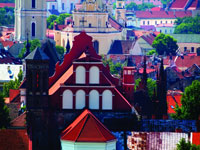 Vilnius OverviewThe Lithuanian capital of Vilnius is somewhat unique compared to
the major cities in the rest of the Baltic States, its old
architecture being a hodge-podge of styles with Scandinavian,
Russian and German influences. The mix blends well into a charming
'Vilnian Baroque', that fills the cobblestone winding streets of
the old quarter. The city is further enhanced by its picturesque
setting in a valley at the confluence of the Neris and Vilnia
rivers, nestling beneath wooded hills in the south-east corner of
Lithuania. Overlooking the city from a central hill is the landmark
Gediminas Castle (named for the medieval Grand Duke who founded the
city) with its impressive tower, from which visitors can enjoy an
unrivalled view of the old town and the shiny new section on the
right bank of the Neris. Gediminas Square is the heart of the old
quarter, featuring the splendid classical cathedral. The city
boasts numerous other interesting churches, beautiful historic
buildings, museums, monuments and parks, and the splendid
University of Vilnius, one of Europe's oldest institutions of
learning, chartered in 1579. In its 'golden age' in the Middle Ages, Vilnius was renowned as
the region's centre for culture and learning, and today it has
reclaimed that reputation, with a packed programme of events always
on the go, from classical music evenings at the Philharmonic
Society Hall and performances at the Opera and Ballet Theatre,
Youth Theatre and Academic Drama Theatre to exhibitions in seven
art galleries and a vast modern art centre. The city also plays
host to numerous commercial fairs and exhibitions annually. Last, but not least, when the sun goes down Vilnius reveals the
fun side of its nature, with a nightlife that is fast gaining a
reputation as the hottest in Eastern Europe. |